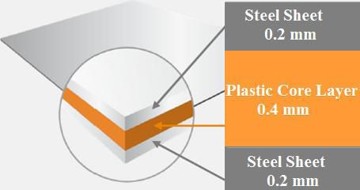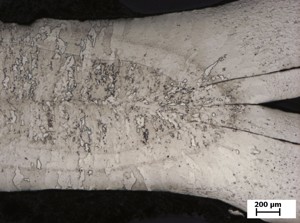Possibilities of processing sandwich sheets (Litecor) using welding and forming methods
Joint research into the weldability of deep-drawing and high-strength steel sheets used for the production of automotive body
components, in particular by resistance spot welding (habilitation thesis was created in cooperation with: Marie Kolaříková,
Ph.D. and several BPs or DPs in the area of resistance welding).
![Used equipment for resistance spot welding - press Dalex PMS 11-4 (left) and MIDIspot (right) [pracoviste/12133/projekty-skoda/sendvicove-plechy/obr01.jpg]](https://fs.cvut.cz/content/images/pracoviste/12133/projekty-skoda/sendvicove-plechy/obr01.jpg)
Fig. 1 Used equipment for resistance spot welding - press Dalex PMS 11-4 (left) and MIDIspot (right)

Fig. 2 Detail of spot joint, unsatisfactory weld - left, matching weld - right, material is 22MnB5 steel, thickness of both sheets is 1,2 mm
Resistance weldability of LITECOR sandwich material, consisting of two steel sheets (HC220Y + ZE), between which a polymeric
material (PE / PA) is placed. Creating a custom type welding fixture that is now covered by intellectual property protection.


The study of the lifetime of the electrodes for resistance welding and the influence of special coatings on weldability (NIT
for deep-drawing steel sheets, Al-Si coatings for Manganese-boron high-strength steels)
![Metallographic cut of welds 22MnB5 + 22MnB5 with AlSi coating welded with optimal welding parameters [pracoviste/12133/projekty-skoda/sendvicove-plechy/image6.jpg]](https://fs.cvut.cz/content/images/pracoviste/12133/projekty-skoda/sendvicove-plechy/image6.jpg)
Fig. 3 Metallographic cut of welds 22MnB5 + 22MnB5 with AlSi coating welded with optimal welding parameters
The result of the solved problems was an understanding of the deeper nature of the process of resistance welding depending on the type of material, its surface treatment, resp. composition and improved quality verification in a non-destructive manner. The resulting knowledge in the area of optimization of welding parameters design and minimization of the resulting defects.
The research was carried out on the formability of LITECOR® sandwich material. The research was mainly focused on bending behavior, deep drawing, and cohesion of surface sheet with a plastic core. The sandwich material after deformation was observed metallographically.
![Example of sheet metal thinning in the pulling radius [pracoviste/12133/projekty-skoda/sendvicove-plechy/fig7.jpg]](https://fs.cvut.cz/content/images/pracoviste/12133/projekty-skoda/sendvicove-plechy/fig7.jpg)
Fig. 4 Example of sheet metal thinning in the pulling radius
![Breach of the top sheet [pracoviste/12133/projekty-skoda/sendvicove-plechy/fig8.jpg]](https://fs.cvut.cz/content/images/pracoviste/12133/projekty-skoda/sendvicove-plechy/fig8.jpg)
Fig. 5 Breach of the top sheet
A study of the wear of the edge during the drawing process was conducted. For this purpose, a test tool was made in cooperation
with ŠKODA AUTO a.s. After a defined number of drawings, the shape change of the tool and its state were monitored.
![Analysed drawing [pracoviste/12133/projekty-skoda/sendvicove-plechy/fig9.jpg]](https://fs.cvut.cz/content/images/pracoviste/12133/projekty-skoda/sendvicove-plechy/fig9.jpg)
Fig. 6 Analysed drawing (1st measurement at 1 cm from right die radius, 2nd measurement in the middle of the drawing, 3rd measurement at 1 cm from left die radius)
![Test drawing tool [pracoviste/12133/projekty-skoda/sendvicove-plechy/image12.png]](https://fs.cvut.cz/content/images/pracoviste/12133/projekty-skoda/sendvicove-plechy/image12.png)
Fig. 7 Test drawing tool
A dissertation thesis (Ing. Tomáš Pilvousek, Ph.D.) was created in cooperation with ŠKODA AUTO a.s. The methodology for
refining the results of numerical simulations of deep drawings using an optical digitization approach and advanced material
models was developed.

Fig. 8 Comparison of real measurement and the result of numerical simulation
A dissertation thesis (Ing. Tomáš Pačák, Ph.D.) was created in cooperation with ŠKODA AUTO a.s. The methodology for
compensation of large automotive stampings was developed.
Categories of car body parts based on the complexity of the forming process and on the geometry.
![Comparison of results of initial springback analysis and last iteration of the compensation [pracoviste/12133/projekty-skoda/sendvicove-plechy/image15.png]](https://fs.cvut.cz/content/images/pracoviste/12133/projekty-skoda/sendvicove-plechy/image15.png)
Fig. 9 Comparison of results of initial springback analysis and last iteration of the compensation
Two more dissertations are being prepared in cooperation with ŠKODA AUTO a.s at this moment. One of them is focused on the
problem of mechanical joining of parts in the construction of the car body and the other one is focused on the application
of high-strength steels for the production of face parts of the body.

Fig. 10 The output of forming simulation for “5th Door Outer Lower” made of two-phase steel.
Several bachelor and master theses are also being written as part of the cooperation.
In collaboration, test tools are used and developed to monitor the formability of materials in detail (Hole Expansion Test, etc.)
In collaboration with:

Contact:
Ing. František Tatíček, Ph.D.
Department of Manufacturing Technology FME CTU in Prague
E-mail: frantisek.taticek@fs.cvut.cz
Phone: +420 224 352 631
![[design/2014/cvut-logo-en-white.png]](https://fs.cvut.cz/content/images/design/2014/cvut-logo-en-white.png)
![[design/2014/cvut-logo-en-print.jpg]](https://fs.cvut.cz/content/images/design/2014/cvut-logo-en-print.jpg)